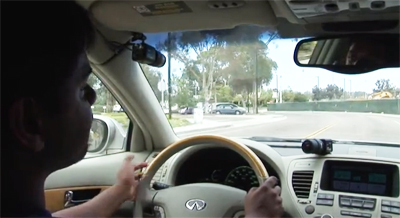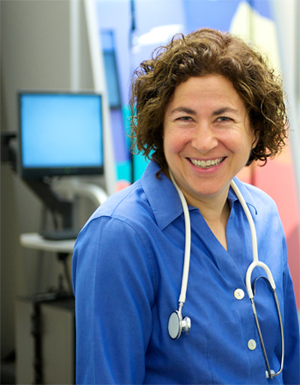
Polling San Diegans About Cell Phones and Driver Safety
By:
- Emily Bass
Published Date
By:
- Emily Bass
Share This:
Article Content

The TREDS program is polling San Diegans aged 30 to 64 about texting and cell-phone use while driving.
Researchers at the University of California, San Diego have launched a new survey aimed at gauging local motorists’ opinions and activities associated with cell-phone usage and driving. It’s part of the Training, Research, and Education for Driving Safety (TREDS) program that has been working to keep Southern California highways – and the drivers navigating them – safe since 2005.
TREDS is led by experts from the UC San Diego School of Medicine’s Injury Epidemiology, Prevention and Research Center (IEPRC). The program includes an ongoing series of training courses for health professionals and law-enforcement officers on how to identify and manage age-related impairments in older drivers.
Understanding – and hopefully curbing – distracted driving is a key TREDS initiative, notes project leader Linda Hill, MD, MPH, professor in the Department of Family and Preventive Medicine at the UC San Diego School of Medicine. “Injuries are the leading cause of death to age 45, and they remain a major source of morbidity and mortality throughout life, with motor vehicle crashes the main cause of injury deaths,” said Hill. “Drivers talking on cell phones are responsible for 1.2 million collisions, 570,000 injuries, and 2,600 deaths each year. We’re hoping that this study will help us learn more about how and why San Diegans use cell phones and other devices while driving, as well as what factors influence their attentiveness to traffic and other road conditions.”
Hill is based in the Center for Wireless and Population Health Systems (CWPHS), a partnership of the School of Medicine and the California Institute for Telecommunications and Information Technology (Calit2).
Survey Details
The new Adult Cell Phone Survey, which went live February 8, focuses on the driving habits of San Diego County residents, ages 30 to 64, who use a cell phone and who drive at least one day each week.
Responses to the 20-minute survey will remain anonymous and cannot be linked back to specific participants. All respondents who complete the survey can enter a lottery for a chance to win an iPad, a Kindle, or one of three $100 Amazon gift cards. The survey can be filled out at https://www.surveymonkey.com/s/TREDS.

Linda Hill, MD, MPH, is a professor in the Department of Family and Preventive Medicine at the UC San Diego School of Medicine, and prinicipal investigator of the TREDS program.
The survey uses the anonymous online questionnaire to examine drivers’ attitudes about cell-phone use and to quantify the amount of time that respondents use cell phones to text or call others while on the road. For example, they are asked when they are most or least likely to talk on the phone or text while driving, and whether they have personally been involved in a collision due to their own cell-phone use.
The survey also asks how respondents perceive the risk of being cited by law enforcement for using a handheld cell phone while driving, and how they rank their own and others’ ability to drive and multitask when using cell phones or other devices.
Drivers’ attitudes about potential deterrents to using a cell phone while on the road – including insurance rate hikes, the addition of “points” to a motorist’s driving record, or having a license suspended – are also measured, as are behavioral changes that may have followed any past cell phone-related collisions or traffic citations.
“We are asking participants in the survey about their understanding of policies that their employers may have instituted regarding cell-phone usage while operating a vehicle, whether it’s owned by the company or not,” said Hill. “We also want to know if the calls made while driving are generally work-related or personal, perhaps initiated out of boredom on the road.”
This new study builds on previous TREDS research into the driving habits of young adults. Close to 5,000 San Diego-area college and university students completed a similar online survey administered in the fall of 2011. A preliminary analysis of that survey’s results indicate that nearly 80 percent of respondents use cell phones to talk or text while driving, and that in general, drivers tend to overestimate vastly their ability to use electronic devices and operate a motor vehicle at the same time.
“These findings are noteworthy because they provide insight into the self-reported habits of a technologically-savvy group of drivers who may not fully understand the dangers of distracted driving,” said Hill. “Our initial survey showed that we need to do more to educate younger drivers about the hazards of distracted driving, for the benefit and safety of everyone on the road. We are eager to discover if similar findings are borne out in our new survey of San Diegans a few years older than the previous cohort, or whether different driving populations view cell phones and other distractions in a different light.”
As with the earlier study, the Adult Cell Phone Survey examines respondents’ opinions about the link between safe driving and distractions that do not involve cell phones or other devices, such as grooming or looking at printed maps. Respondents to the earlier study reported more than one thousand collisions caused by distracted driving, with such routine activities as reaching for an object or chatting with a passenger being more likely causes of collisions than texting or talking on the phone while driving.
An important research topic that is new to the Adult Cell Phone Survey explores how sharing a vehicle with children may influence driving habits. Survey respondents are asked to note whether driving with children 11 years or younger, or ages 12 to 17, plays a role in how and when they use cell phones.
A separate survey of 1,700 American teenagers found that teen drivers tend to mirror their parents’ behavior behind the wheel, from not buckling up to speeding or texting while driving. Citing this teen survey, Hill noted that, unfortunately, “distracted driving can be passed on to the next generation when kids witness their parents becoming preoccupied with activities other than driving, even though it’s the primary task at hand.”
According to Hill, researchers will use results of the Adult Cell Phone Survey to target specific interventions and education methods to improve driver habits of both generations. “The upshot is that children – and their parents – can unlearn bad behaviors with proper guidance and training,” she noted, “but first we have to identify those behaviors.”
The anonymous nature of the new TREDS survey is expected to encourage respondents to report all of their driving habits accurately, including potentially dangerous ones that they may not usually disclose. TREDS researchers will use data gleaned from the survey to improve their understanding of how factors such as traffic congestion, weather conditions, or passenger loads affect drivers’ use of cell phones and lead to other activities that draw their eyes off the road. “Distracted driving has become relatively commonplace, but it doesn’t need to be that way,” concluded Hill. “By learning more about the ‘hows’ and ‘whys’ of driver inattention, we can take steps to educate the public about how to keep our roads safe.”
The survey team, led by Hill, includes deputy director Jill Rybar, MPH; training coordinator Tara Styer, MPH; and Ph.D. student Jessa Engelberg. The survey is partially supported by a gift from Allstate Insurance Company. For additional information, contact TREDS@ucsd.edu or call 858-534-9330.
Share This:
You May Also Like
Stay in the Know
Keep up with all the latest from UC San Diego. Subscribe to the newsletter today.


